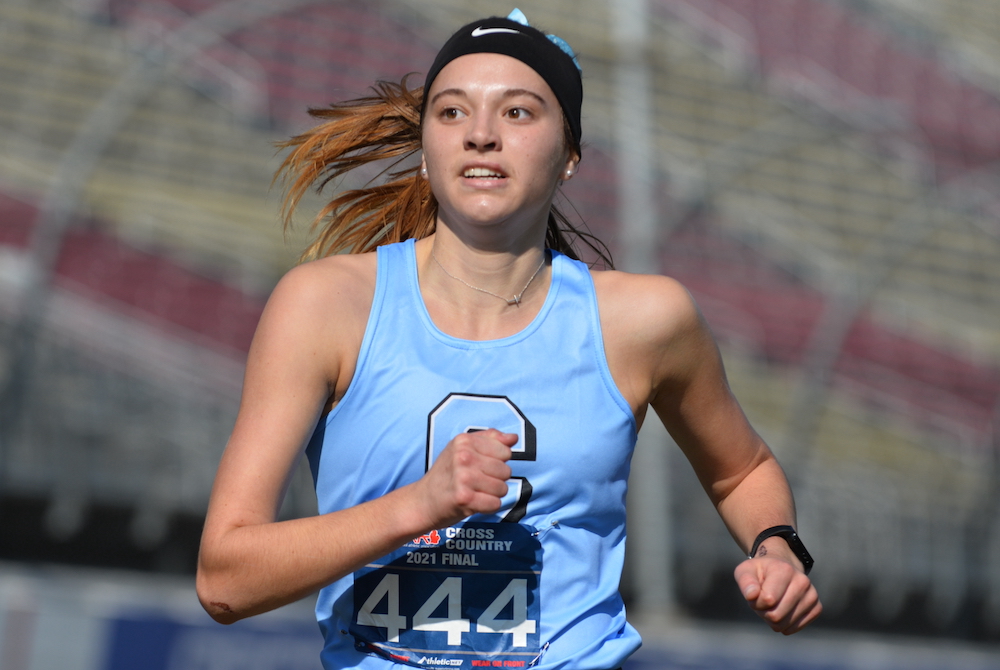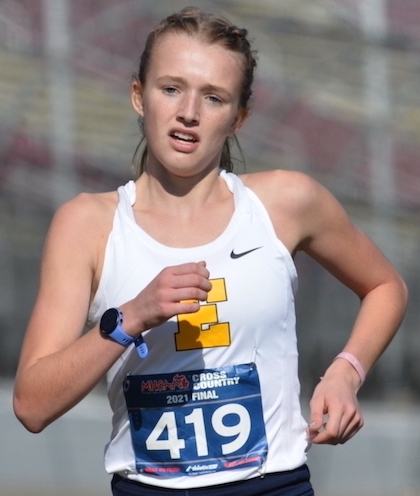
Eagles' Frens, East Grand Rapids Find Fast Gears at Finals Time
November 6, 2021
BROOKLYN — The clock was ticking on Madelyn Frens’ hopes of winning an MHSAA cross country championship in her final season at Grand Rapids Christian.
After running a blistering time of 17:56.0 on Aug. 28 at the Pete Moss Invitational at Benzie Central, Frens was sidelined with a stress reaction in her right femur.
Cross country season is short. Any time away from training and racing makes it less likely a runner will be successful come championship time.
But after going nearly four weeks without a race, Frens returned without missing a beat. With five races as a build-up for the MHSAA Lower Peninsula Division 2 Final, Frens pulled away from a five-way battle for the championship to win in 17:52.30.
The time away from running was actually beneficial for Frens.
 “I was able to have a lot of time just to think about myself and what running actually means to me,” she said. “It doesn’t define all of who I am.”
“I was able to have a lot of time just to think about myself and what running actually means to me,” she said. “It doesn’t define all of who I am.”
It was in her second race back, an Ottawa-Kent Conference White jamboree Oct. 6 that she won in 18:11.9, that Frens knew she was still on track to become a Finals champion.
“I was like, ‘I’ve still got this; my team’s got this,’” Frens said.
Her team finished second with 99 points behind East Grand Rapids, which had 66.
It was the third MHSAA team championship in four years for East Grand Rapids, which took second last year to Petoskey. Grand Rapids Christian was third last year.
East Grand Rapids put four runners in the top 15, with sophomore Drew Muller placing fifth in 18:23.28, senior Ainsley Workman ninth in 18:55.57, freshman Sadey Seyferth 12th in 18:58.41, sophomore Sophia Lado 15th in 19:05.87 and junior Abigail Petr 52nd in 19:50.93. All seven Pioneers broke 20 minutes.
Following Frens across the line were four sophomores who will likely have more battles just like this in the next two years. Early leader Mary Richmond of Frankenmuth was second in 17:56.01, Meghan Ford of Mason was third in 18:10.81, Natalie VanOtteren of Grand Rapids Christian was fourth in 18:13.46 followed by East Grand Rapids’ Muller in 18:23.28. There was a 22-second gap after that before the next wave of runners reached the line.
It was the most competitive race of the day, with five runners within three seconds of one another at the two-mile mark. Frens was fourth at the mile and third at the two mile.
PHOTOS (Top) Grand Rapids Christian’s Madelyn Frens pulls away during the final stretch of Saturday’s LPD2 championship race. (Middle) Drew Muller leads a group of eventual high-placing East Grand Rapids runners in their team title pursuit. (Click for more from RunMichigan.com.)

MHSAA Vault: MIS Rose to Challenges to Host 2020 LP Finals
By
Rob Kaminski
MHSAA benchmarks editor
November 12, 2021
The “MHSAA Vault” features stories from past publications and other documents in the MHSAA Library. This issue takes a look at the MHSAA Cross Country Finals at Michigan International Speedway, which celebrated 25 years in 2020 – although it was an event that nearly didn’t happen last fall …
In 1996, the MHSAA and Michigan International Speedway began a partnership the changed the course of the Lower Peninsula Cross Country Finals – quite literally.
The land in and around the track at Brooklyn would host the Finals for all classes of runners in one place on one day, an annual festival of nearly 2,000 runners competing for the MHSAA’s top honors.
Even skeptics – and there were several among running purists who thought the course was too flat, for example – can’t deny the results.
Finals attendance nearly doubled in that first year, and crowds in excess of 10,000 have enjoyed a day of racing several times, including a record 12,153 in 2011.
Enthusiastic crowds were the norm in recent years, with 11,232 in 2017, and nearly 11,000 in 2018 (10,989) and 2019 (10,873).
In fact, attendance failed to reach at least 8,000 only twice since the move to MIS.
Of course, last year was an exception, when attendance was limited to 1,000 spectators per session due to the COVID-19 Pandemic. Fans also were restricted to the grandstands rather than following the action throughout locations on the course.
To reduce the number of runners in each race, the event was spread over two days, with each Division being run in two separate “sections” with times then combined at the end to determine team and individual champions.
While not ideal, the end result was another year of fantastic efforts at MIS – both from student-athletes and those behind the scenes.
“Even at the last hour, less than a week ahead of the Finals, we were closer to not having the Finals than we were to having them,” said MHSAA Assistant Director Cody Inglis, who coordinates the cross country postseason. “Rumors and challenges of mandated shutdowns, testing and other requirements were being discussed and caused a lot of unknowns. Even at the Regional level, we had schools, Regional courses and hosts shutting down their facilities; we had to relocate four Regionals 48 hours prior to race times. That scenario just could not happen at the Finals level where far more runners and much more travel would be involved.”
Among the many last-minute hurdles was the edict from NASCAR – which owns MIS – that all persons on site be temperature checked upon entry. That meant securing thermometers that were easy to operate in short order, along with personnel necessary to conduct the readings.
The attendance limitations certainly helped to implement the temperature screening, but brought their own issues.
“Limiting spectators was not a popular decision, but it really was the only way to have a race,” Inglis said. “We were taking direction and working with policies and protocols from the MDHHS, the Governor’s office, Lenawee County Health Department, MIS and NASCAR.”
Part of the solution was to utilize the grandstands as a “barrier” between participants and spectators. The reduced number of fans were dispersed over thousands of seats while still allowing them the chance to watch their student-athletes compete.
“It wasn’t the same, it wasn’t easy or perfect, but it was what we had to do to have a race,” Inglis said. “Separating the Finals into two days and different sections also allowed us to spread out the event and limit the number of people on site at any one time. This was a key part of the plan and worked well even though it separated races within a Division.”
The MHSAA, MIS and the cross country community never lost focus of the main goal: a culmination of the season for the student-athletes, who deserved something last year more than ever. And, more than ever, MIS once again displayed its advantage as a venue that could adapt to the fluid nature of the times to pull off the event.
“There were some thoughts of using four different sites, but as we learned during the Regionals, the climate of things was so tenuous from one area of the state to another that we couldn’t be 100-percent certain that there wouldn’t again be last-minute cancelations,” Inglis said. “MIS was wonderful to work and collaborate with, and was the best option to get it done. It was never mentioned once publicly about the possibility of not having the Finals – only how we could best do it under uncharted conditions.”
The moving parts and ever-changing scenarios created more complexity than ever in finalizing a season, but every decision was made with the complete desire to conduct the Finals as close to normal as possible.
“I firmly believe that a finish to the season, no matter the differences in race formatting and fan experience, was something everyone would have taken when the season began in August,” Inglis said.
Indeed, the finish line in Year 25 at MIS might have been the most gratifying of them all.

